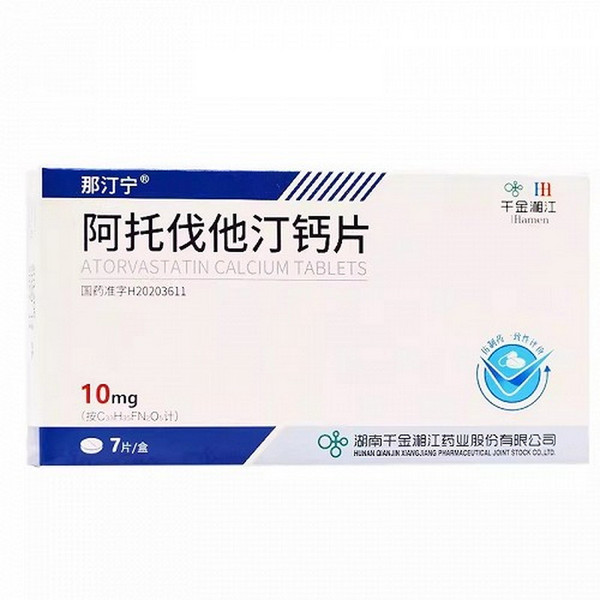Product Overview
[Drug Name]
Generic Name: Atorvastatin Calcium Tablets
Trade Name: Natinine Atorvastatin Calcium Tablets 10mg x 7 tablets
[Main Ingredients]
The main ingredient of this product is atorvastatin calcium, chemically named: [R-(R*,R*)]-2-(4-fluorophenyl)-β,δ-dihydroxy-5-(1-methylethyl)-3-phenyl-4-[(anilino)carbonyl]-1H-pyrrole-1-heptanoic acid calcium salt (2:1) trihydrate
[Properties]
Atorvastatin calcium tablets are white, oval film-coated tablets.
[Indications/Main Functions]
This product is indicated for the treatment of elevated total cholesterol, LDL cholesterol, apolipoprotein B, and triglycerides in patients with primary hypercholesterolemia, including familial hypercholesterolemia (heterozygous) or combined hyperlipidemia (equivalent to Fredrickson classification types IIa and IIb), who have not responded satisfactorily to dietary therapy and other non-drug therapies. In patients with homozygous familial hypercholesterolemia, atorvastatin calcium can be used in combination with other lipid-lowering therapies or alone (when other treatment options are unavailable) to lower total cholesterol and LDL cholesterol.
[Drug Interactions]
Atorvastatin calcium tablets should be used in patients with allergies to any of the ingredients. This product is contraindicated in patients with active liver disease, persistent elevations of serum transaminases exceeding three times the upper limit of normal for unknown reasons, myopathy, and during pregnancy, lactation, or in women of childbearing age who are not taking adequate contraceptive measures.
[Specifications]
10mg*7 tablets
[Dosage and Administration]
Patients should follow a standard low-cholesterol diet before starting treatment with this drug and maintain a healthy diet throughout treatment. The dose should be individually adjusted based on baseline LDL cholesterol levels, treatment goals, and the patient's response to treatment. The usual starting dose is 10 mg once daily. Dosage adjustments should be made every four weeks or longer. The maximum dose is 80 mg once daily. Atorvastatin can be taken once daily at any time of day, regardless of mealtime. For patients with established coronary artery disease or other patients at increased risk of ischemic events, the treatment goals are LDL-C <3 mmol/L (or <115 mg/dL) and total cholesterol <5 mmol/L (or <190 mg/dL). Excerpted from "Prevention and Treatment of Coronary Artery Disease in Clinical Practice: Second Joint European Recommendation for the Prevention of Coronary Artery Disease," Journal of Atherosclerosis, Vol. 140, 1998, pp. 199-270. For the treatment of primary hypercholesterolemia and combined hyperlipidemia, most patients can achieve lipid control with atorvastatin calcium 10 mg once daily. Significant efficacy is seen within two weeks of treatment, with maximum efficacy achieved within four weeks. Efficacy is maintained with long-term treatment. For patients with heterozygous familial hypercholesterolemia, the initial dose is 10 mg daily. Dosage should be individualized and titrated to 40 mg daily at four-week intervals. If satisfactory efficacy is still unsatisfactory, the dose can be increased to a maximum of 80 mg daily or combined with a bile acid sequestrant at 40 mg daily. For the treatment of homozygous familial hypercholesterolemia, in a charitable study of 64 patients, 46 of whom had LDL receptor information, the average LDL-C reduction among these 46 patients was 21%. The dose of atorvastatin can be increased to 80 mg daily. For patients with homozygous familial hypercholesterolemia, the recommended dose is 10-80 mg daily. Atorvastatin calcium should be used as an adjunct to other lipid-lowering therapies (e.g., LDL-C plasma dialysis). Alternatively, when these treatment options are unavailable, this product can be used alone. Dosage in Patients with Renal Insufficiency: Renal disease does not affect the plasma concentration of this product or its lipid-lowering effect, so no dose adjustment is required.
[Adverse Reactions]
The most common adverse reactions to this product are constipation, flatulence, dyspepsia, and abdominal pain, which generally resolve with continued treatment. Less than 2% of patients in clinical trials discontinued treatment due to adverse reactions related to this product. Based on clinical study data and extensive postmarketing experience, the adverse events associated with Lipitor are listed below. Conventionally, the estimated frequency of adverse events is ranked as follows: common (<1/100, 1/1000, <1/100); rare (<1/10,000, <1/1000); and very rare (<1/10,000). Gastrointestinal Disorders Common: constipation, flatulence, dyspepsia, nausea, diarrhea. Uncommon: anorexia, vomiting. Blood and Lymphatic System Disorders: Uncommon: Thrombocytopenia. Immune System Disorders: Common: Allergic reaction. Very Rare: Anaphylactic reaction. Endocrine Disorders: Uncommon: Alopecia, hyperglycemia, hypoglycemia, pancreatitis. Psychiatric Disorders: Common: Insomnia. Uncommon: Amnesia. Nervous System Disorders: Common: Headache, dizziness, paresthesia, dysesthesia. Uncommon: Peripheral neuropathy. Hepatobiliary Disorders: Rare: Hepatitis, cholestatic jaundice. Skin/Extremities: Common: Rash, pruritus. Uncommon: Urticaria. Very Rare: Angioedema, bullous rash (including erythema multiforme, Stevens-Johnson syndrome, and toxic epidermolysis). Ear-Labyrinth Disorders: Uncommon: Tinnitus. Musculoskeletal Disorders: Common: Myalgia, arthralgia. Uncommon: Myopathy. Rare: Myositis, rhabdomyolysis. Reproductive System Disorders: Uncommon: Impotence. General Abnormalities: Common: Asthenia, chest pain, back pain, peripheral edema. Uncommon: Malaise, weight gain. Studies: As with other HMG-CoA reductase inhibitors, elevations in transaminases have been reported in patients taking this drug. However, these changes are generally mild, transient, and do not require treatment interruption. Clinically significant elevations in serum transaminases (>3 times the upper limit of normal) occurred in 0.08% of patients treated with this drug. These changes were dose-related and reversible in all patients. Similar to other HMG-CoA reductase inhibitors in clinical trials, 2.5% of patients taking this drug experienced elevations in serum creatine phosphokinase (CPK) greater than 3 times the upper limit of normal. 0.4% of patients taking this drug experienced elevations greater than 10 times the upper limit of normal.
[Contraindications]
Atorvastatin calcium tablets are contraindicated in patients with a known hypersensitivity to any of the ingredients. This product is contraindicated in patients with active liver disease, those with persistent elevation of serum transaminases exceeding 3 times the upper limit of normal for unknown reasons, myopathy, pregnant women, lactating women, and any women of childbearing age who have not taken appropriate contraceptive measures.







